Nick Metcalfe's Blog, page 5
June 24, 2019
More Royal Signals Gallantry Awards
There are now some additions to the blog that supports my project examining Royal Signals gallantry awards:
A photograph appeared in The Wire in June 1959 under the heading: ‘Who are they? Where are they now?’ I answered the question almost 60 years on (!) and a version of that appeared in The Wire in the Winter 2018 (i.e. January 2019) edition. The photo below is linked to a pdf of the article:
Having been sent the diaries of the Chief Signal Officer China Command, Lieutenant Colonel E. O. Levett OBE, and having read the outstanding story of the Royal Canadian Corps of Signals detachment sent to Hong Kong by D. Burke Penny, I was able to update the story of the Hong Kong Signal Company.
Finally, I wrote a piece about Royal Signals gallantry awards on D-Day. The photo of Lance Corporal Danny Bowstead MM below is linked to the story.
January 8, 2019
Royal Signals Gallantry Awards
I have been very busy on my Royal Signals gallantry awards project and have not written as much for this blog as I should have. Here are my last two offerings from the Royal Signals project:
The first is a commemoration about the end of the Palestine Mandate, some of the gallantry awards earned and the loss of Royal Signals soldiers to terrorism there in the post-war years. PALESTINE 1920-1948: IN MEMORIAM
[image error]
Captain Alexander David Mackintosh, Palestine Command Signal Regiment – shot and mortally wounded by the terrorists who planted the bomb at the King David Hotel on 22 July 1946; he died the next day.
The second is about NCOs and the Military Cross. The medal became available to all ranks after the 1993 review of gallantry decorations and medals. This blog post looks at two NCOs who wore the ribbon of the Military Cross long before that. NON-COMMISSIONED OFFICERS AND THE MILITARY CROSS
[image error]
The grave of Lance Sergeant Dennis Edwin Ward MC, Royal Signals, who died in a traffic accident near Kohat in India on 1 February 1936.
August 23, 2018
For Exemplary Bravery – The Queen’s Gallantry Medal
Following the Civilian Gallantry Awards List published in the London Gazette in July 2018, I have updated the addendum to For Exemplary Bravery—it records all of the 29 Queen’s Gallantry Medals awarded since December 2013, new information about a number of previous recipients and new photographs. The addendum is a pdf in the same format as the book and it can be downloaded (free) from the book’s website.
[image error]
The medals of former Warrant Officer Class 1 John Wilkinson McNair QGM, who earned his award during and in the aftermath of an attack by artillery and tanks on civilians at Konjević Polje in Bosnia and Herzegovina in 1993.
May 20, 2018
Major Robert Norman Dodds MBE, MC, DCM, MM
Robert Dodds served during the First World War in France and Flanders with the Royal Engineers Signal Service, earning a Distinguished Conduct medal and Military Medal. Commissioned in 1918, he then added an Military Cross to his list of decorations in North Russia in 1919. He served with Royal Signals during the Second World War, earning an MBE for his conduct during the withdrawal from Tobruk to El Alamein.
Read his story on the website of my Royal Signals gallantry awards project:
Major R N Dodds MBE, MC, DCM, MM
[image error]
March 19, 2018
March 1918 – Sergeant James Hughes DCM, MM
The medals of Sergeant James Hughes DCM, MM
In March 1918, for the third time in 21 months, the 9th Royal Irish Fusiliers in 108th Brigade, 36th (Ulster) Division was all but destroyed. Blacker’s Boys devotes a whole chapter to the actions fought in the week following the German attack south of the River Somme and the subsequent action against the German second phase attack south of Ypres.
In these actions, 36th (Ulster) Division suffered over 7,200 casualties, of which over 5,600 were missing, most of whom had been captured. This was the highest casualty rate of any division facing the German attack. The 9th Royal Irish Fusiliers lost 46 killed or died of wounds, 142 wounded and an estimated 334 captured. By this stage of the war the Battalion was nothing like that which had landed in France in October 1915. The majority of its men were those who had joined from 2nd North Irish Horse, there was also a fair number of Englishmen—from Yorkshire, Derbyshire and London—and Irish soldiers from all over Ireland, both Catholic and Protestant.
Many of the men killed in the actions fought in March 1918 were later described as falling in the period 21-29 March or on 29 March but neither of these descriptions is wholly accurate. All of those who were killed in action fell between 21 March and the Battalion’s last stand at Erches on 27 March. No-one was killed in action on 28 or 29 March but the latter was the first day that the Battalion was able to compile its records of killed, wounded and missing. The fate of one gallant NCO illustrates this perfectly:
[image error]
Sergeant James Hughes DCM, MM
4517 Company Quartermaster Sergeant James Hughes MM, a fruit dealer and widower from John Street, Portadown, was a pre-war member of the Armagh Regiment, Ulster Volunteer Force. He was also a Special Reservist and on the outbreak of war he had been mobilised and posted to the 1st Royal Irish Fusiliers, with which he went to France on 22 August 1914. He was wounded in the face in October 1916 and earned a Military Medal in the fighting at the Chemical Works at Roeux in April and May 1917.[1] Posted to the 9th Royal Irish Fusiliers after he had recovered, he was appointed Company Quartermaster Sergeant in ‘A’ Company.
At Ollezy, on the southern bank of the River Somme, on 23 March the Battalion fought a gallant rearguard action during which Company Quartermaster Sergeant Hughes ‘went forward with a Lewis gun and knocked out an enemy machine-gun which was firing on our right flank. When the team was disabled, although wounded himself, he kept the gun in action until reinforcements came up.’ So recorded the citation of his Distinguished Conduct Medal.[2] Hughes, having been wounded in this action, was later declared missing in the period 21-28 March and finally declared killed in action on 29 March. He died, in fact, on 23 March, the day of his gallant stand and was buried by the advancing Germans, who recorded the date of his death. He was one of 85 British soldiers buried in March and April in a section of the German military cemetery south of Roye; that section became known as Roye Old British Cemetery. His remains were reinterred in Roye New British Cemetery in 1920.[3] Buried two graves along is 41126 Private James Frazer Johnston, born in Clogher, County Tyrone and from Blacklion, County Cavan, who served with 2nd North Irish Horse before joining ‘A’ Company when the units amalgamated in September 1917; he died of wounds on 25 March; he too was reinterred in 1920. Also buried here are two officers of the Battalion: Major John George Brew, who died of wounds in captivity on 6 April 1918, and Second Lieutenant William Henry Roche, who was killed in action on 27 March 1918 at Erches. There are also three soldiers of 1st Royal Irish Fusiliers buried here: 8746 Private Joseph Adamson, captured on 21 March 1918 and died in captivity in a military hospital at Ham on 6 June 1918 from an abdominal gunshot wound; 18114 Private Walter Behan, wounded in the head, captured and died of wounds in a German military hospital in Goyencourt on 2 April 1918; and 41810 Private Alexander Patrick, killed in action on 24 March 1918.
James Hughes’ grave has been visited previously by three later generations of his family and this year, the 100th anniversary of his death, they will visit again.
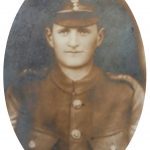
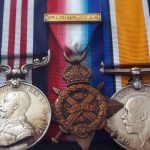
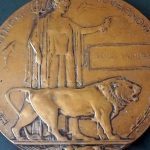
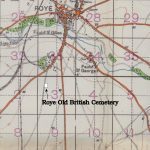
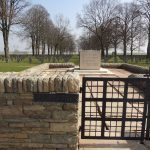
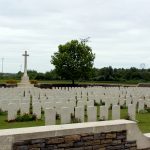
1. (Back) London Gazette 9 July 1917. 30172, p 6831.
2. (Back) London Gazette 3 September 1918. 30879, p 10309.
3. (Back) Section IV, Row B, Grave 1.
March 18, 2018
21 March 1918 – Racecourse Redoubt
One hundred years ago, on 21 March 1918 on the first day of the German offensive that swept back the British Fifth Army, my great-uncle Robbie was captured in the ‘Line of Resistance’ at the very front of the defensive positions held by 15th Royal Irish Rifles in 107th Brigade in 36th (Ulster) Division. His story is here.
[image error]
107th Brigade Forward Zone
‘Twice they got out on top and walked along it, clearing enemy out of it with rifle and rifle grenades.’
Farther back, ‘D’ Company held out in Racecourse Redoubt until that evening. During the attacks there in the morning, one of ‘D’ Company’s platoon commanders, Second Lieutenant Edmund De Wind, defended his position most gallantly and, assisted by Corporal Samuel Getgood and Lance Corporal Hubert Walker MM, repeatedly cleared the enemy from a trench at the west of the redoubt. Around midday De Wind was killed; Getgood and Walker were captured when the redoubt was surrendered that evening. For their gallantry De Wind was posthumously awarded the Victoria Cross and Getgood and Walker were awarded the Distinguished Conduct Medal.
Recently I was able to help a descendent of De Wind put together some of his story, in preparation for a commemorative event in Comber, Northern Ireland, De Wind’s home town prior to his emigration to Canada. It is with his permission that I can show these fabulous photographs of his Victoria Cross.
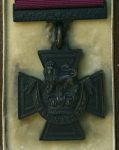
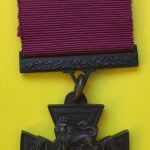

November 17, 2017
Royal Signals Gallantry Awards 1920-2020
The Royal Signals Gallantry awards centennial project now has a Facebook page:
The project website is here.
November 15, 2017
My Family at War – Part 7:
2097365 Leading Aircraftwoman Marie Tarrant Neill
[image error]
Leading Aircraftwoman Miriam Neill
Miriam, as she was known all her life, was the third of the five daughters of my great-grandfather William Neill; she had an older brother who died in infancy whom she never met, and the family later adopted a son.[1] Marie Tarrant Neill was born on 16 August 1910 in the family home at James Street in Lurgan, to which they had recently moved.
The Women’s Auxiliary Air Force was created on 28 June 1939 from the 48 companies of the Auxiliary Territorial Service supporting the Royal Air Force. Conscription of women began in 1941 and Miriam Neill was enrolled into the WAAF that year on 24 July. Having reported for training on 11 September 1941, she completed her basic training and was posted as a tailoress to RAF Box (later renamed RAF Rudloe Manor) in Wiltshire, the site of the Operations Centre of No. 10 Group RAF. She was billeted at Hartham Park, a Georgian manor house just north of Corsham.
[image error]
RAF Box (RAF Rudloe Manor)
She remained there throughout the war, apart for a period spent at the WAAF Convalescent Depot, Studley Priory in the autumn of 1945. The reason for her medical treatment is unknown but after leave at home over Christmas and New Year 1945/46, she returned to duty. As a result of ‘ceasing to fulfil WAAF physical requirements’, Leading Aircraftwoman Neill was discharged on 15 August 1946. On discharge her trade proficiency was graded ‘superior’. For her war service she was awarded the British War Medal 1939-45 and the Defence Medal.
Miriam Neill died on 27 January, 2003, aged 92, and was buried with her parents and sister Olive in Lurgan New Cemetery.
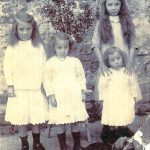
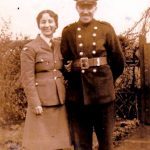
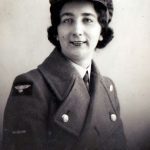
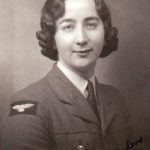
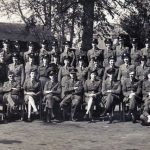
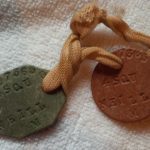
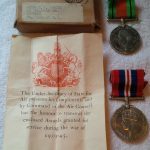
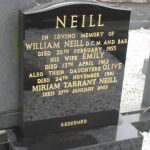
1. (Back) Elizabeth Ellen (known as Cissie) (later Woods) (12 August 1900-NK), Olive (28 September 1902-24 November 1981), Annie, my grandmother, (26 November 1907-31 August 1961), and Mary (known as May) (later Gardiner) (30 July 1913-1995). A son, Joseph (known as Joey), was born on 22 September 1898 but died on 20 March 1901. The adopted son was Hamilton (known as Teddy) (18 December 1922- 13 August 2006).
September 30, 2017
The Sinking of the SS Lisbon Maru
On 1 October 1942, the SS Lisbon Maru, a Japanese freighter transporting prisoners of war from Hong Kong to Japan, was sunk by the submarine USS Grouper.
Fifty Royal Signals soldiers died. This is their story and that of the most gallant Signalman Arnold Topliff.
[image error]
SS Lisbon Maru
[image error]
We Shall Suffer There by Tony Banham
I must acknowledge the help given by Tony Banham in the preparation of this story. His three books on the Battle for Hong Kong, the sinking of the SS Lisbon Maru, and the fate of the prisoners of war are masterly and highly recommended.
See Hong Kong War Diary.
September 22, 2017
Discovering The North-West Passage
 Discovering the North-West Passage: The Four-Year Arctic Odyssey of H.M.S. Investigator and the McClure Expedition by Glenn M. Stein
Discovering the North-West Passage: The Four-Year Arctic Odyssey of H.M.S. Investigator and the McClure Expedition by Glenn M. Stein
My rating: 5 of 5 stars
This is an outstanding piece of work. Ignoring for one moment the incredible story of the crew of HMS Investigator, this 19th Century tale of exploration is superbly researched and documented; as a reference work for the serious student of the history of exploration in the Arctic and Antarctic it is a ‘must read’. The bibliography is extensive, the notes on the primary sources lend much weight to the author’s conclusions and the tale itself is well told, without hyperbole or flights of imagination. I ordered this from a library in order to study Stein’s history of the Polar Medal. Before beginning the book I read the notes on the sources and I’m glad that I did so first.
Although there is room for a lighter telling of this tale (which I think would please some of the reviewers of this book elsewhere) some events in history require a serious and scholarly study to be worthy of the efforts of those whom it describes and to sit as the definitive historical record. This is such a work and I highly recommend it.



